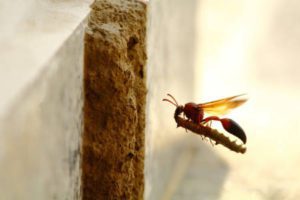“A SCARY WASP IS TRYING TO GET INSIDE!”
By Zachary Ciras on July 20, 2020.
We recognize yellowjackets and most of us know a paper wasp’s “umbrella” nest when we see it near the ceiling of our front porch. These familiar wasps are all social wasps, meaning many wasps live together in a colony and share nest-keeping duties. But there are many other kinds of wasps that we don’t see as often that don’t live in colonies. When we do see an unfamiliar wasp on or near our home, it can be a little unnerving not knowing its intentions.
SOLITARY WASPS ARE NOT AGGRESSIVE
Compared to social wasps, solitary wasps live, hunt, and nest alone. Usually a single female wasp selects the nest site, then constructs and provisions a small nest designed to hold a few eggs. The whole process takes only days, then the wasp seals the nest and moves on, leaving her larvae to develop on their own.
The female solitary wasp has a stinger and can use it defensively, but she rarely does so. Not being part of a large colony, she is not programmed to expect threats to the nest, plus she is very busy. If you leave her alone, she’ll leave you alone (see Can That Thing Sting Me?).
Believe it or not, all wasps and bees are considered to be beneficial insects. Bees, and wasps too, help to pollinate plants. The main benefit provided by wasps is that they collect plant-feeding insects or other pests to feed to their larvae. When provisioning their nests, wasps will sting and paralyze smaller insects or spiders and carry them back to the nest, provisioning each larval cell with this “baby food” before laying an egg.
THREAD-WAISTED WASPS ARE JUST ONE GROUP OF SOLITARY WASPS
Different species of solitary wasps have very different habits, build different types of nests, and paralyze different types of prey. One example is the mud dauber wasp that collects soft mud and plasters it onto a wall or vertical surface to create a tubular nest chamber that it will provision with paralyzed spiders (see What Are Those Mud Tubes on the Outside of My House?). In our region, mud dauber wasps that spent the winter in their mud nests are emerging, leaving circular exit holes in the tubes.

Thread waisted mud wasp carrying prey back to the nest. Shutterstock.
Many solitary wasps are known as thread-waisted wasps because only a narrow tubular segment connects their abdomen to their thorax. Mud dauber wasps are an example of this body type. When these wasps fly, their long legs dangle beneath them.
We are getting calls about the appearance in our area of another thread-waisted wasp known as the grass-carrying wasp. Homeowners often find evidence of her nest building when they open windows to find the track stuffed with dried grass!
When constructing her nest, the female will be seen flying and carrying a blade of grass longer than herself in her mouth. She uses existing small holes in trees, posts, equipment, and other sites for her nest. This grass-carrying wasp gets attention (see blog title above) because the track space between windows and screens or storm windows is a favorite nest site that is just the right size. The wasp transports many grass blades to separate her provisioned egg cells after she inserts paralyzed tree crickets to feed the hatching larvae.
WHEN DO WASPS REQUIRE CONTROL?
Because wasps are beneficial, we don’t want to eliminate them unless necessary. You’ll probably know when that is. While most of us have a lower tolerance level for the more aggressive yellowjackets, solitary wasps are a lot easier to tolerate. Besides, solitary wasps are usually only around for a short time since there is no growing nest to take care of. Nevertheless, there can be times when even solitary wasps might require control or at least, some intervention in their choice of nest site. Like all wasps and bees, solitary wasps can react, and may sting, if their nest is threatened. Consider control measures if:
- The nest-building activity is too close to doorways, walkways, decks, patios, play areas, sheds, or other sites where children, pets, and others might come into accidental contact with the wasps.
- Nests are being constructed inside barbeque grills, deck chairs, lawnmowers, boats, or other yard or recreation equipment that is frequently used.
- A resident or visitor to the home or building is highly allergic to wasp or bee stings. Then nests that might otherwise have been left alone should probably be destroyed. The chance of anaphylactic shock and possible death from a sting is too great a risk.
Any time that you’re not sure of the type of wasp that is nest-building, give Colonial Pest a call. We’ll identify it and let you know if control measures are necessary. For more information specific to our region, check out this audio interview – Summer Pests: Wasps